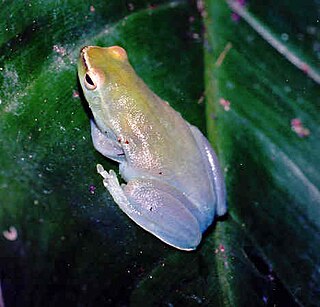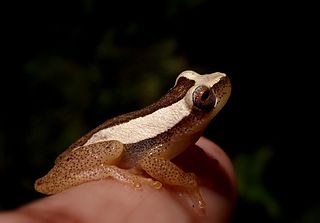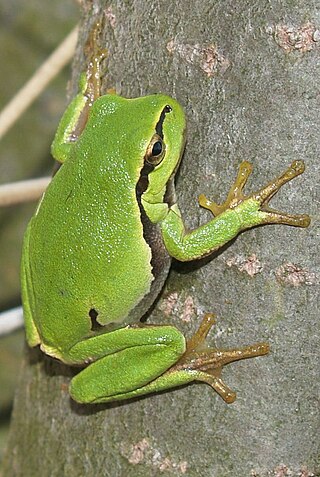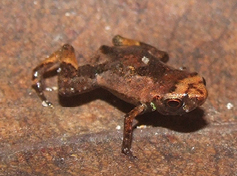
Hylidae is a wide-ranging family of frogs commonly referred to as "tree frogs and their allies". However, the hylids include a diversity of frog species, many of which do not live in trees, but are terrestrial or semiaquatic.

Sphaenorhynchus is a genus of frogs in the family Hylidae. They are also known as lime treefrogs or hatchet-faced treefrogs. They are found in the Amazon and Orinoco River basins of South America, the Guianas, Trinidad, and southern and eastern Brazil. The majority of the species are associated with the Atlantic Forest domain in Brazil.

Nyctimantis is a genus of frogs in the family Hylidae. The genus is found in south-eastern Brazil as well as in the Orinoco Basin in Venezuela, Colombia, and Brazil. These are tree-dwelling species usually hiding in the cisterns of epiphytic bromeliads. The top of the head carries a bony plate which is fused with the skin.

Adelophryne is a genus of frogs in the family Eleutherodactylidae. They are native to northern South America east of the Andes, known roughly from the area corresponding to the Guiana Shield, as well as to the coastal area of Bahia, Brazil. Whether the genus is truly distinct from Phyzelaphryne remains uncertain. Common name shield frogs has been proposed for this genus, although the stem flea frog is used for some species.

Euparkerella, sometimes known as Guanabara frogs, is a genus of frogs in the family Strabomantidae. They are endemic to the Atlantic coastal forests in the south-eastern Brazilian states of Espírito Santo and Rio de Janeiro. The name Euparkerella honours H. W. Parker, a herpetologist who named the type species, with the Greek prefix eu meaning true and suffix ella, a diminutive form.

Bruno's casque-headed frog is a species of frog in the family Hylidae. Endemic to Brazil, its natural habitats are subtropical or tropical moist lowland forests, subtropical or tropical moist shrubland, and intermittent freshwater marshes. It is threatened by habitat loss. The specific name brunoi was in honour of Dr Bruno Lobo, Professor and Director of the National Museum of Brazil (1915-1923).

Dendropsophus branneri is a small hylid tree frog endemic to the Atlantic Forest region of Brazil. It feeds mainly on arthropods and is preyed upon by various invertebrates and vertebrates. Although currently classified by the IUCN Redlist as "least concern", D. branneri suffers rapid habitat loss due to residential development, agriculture, logging, and clearing for pastureland. Male D. branneri are noted for their fighting call, which differs significantly in frequency, duration, and pulses per call compared to their mate advertisement call. Males are also noted for their willingness to escalate physical altercations against other males, which includes kicking, pushing, and wrestling their opponent into non-dominant positions. Unlike most other frog species, D. branneri can breed in both temporary and permanent pools allowing it to inhabit a wide variety of habitats leading to its wide distribution.

Dendropsophus haddadi is a species of frog in the family Hylidae. It is endemic to eastern Brazil, with its distribution ranging from northern Espírito Santo to Bahia, Sergipe, Alagoas, Pernambuco. The specific name haddadi honors Célio F. B. Haddad, a Brazilian ecologist and herpetologist.

Itapotihyla is a genus of frogs in the family Hylidae. It is monotypic, being represented by the single species Itapotihyla langsdorffii, commonly known as the ocellated treefrog. It is found in the Atlantic Forest biome of Brazil, with an isolated population in eastern Paraguay and adjacent Brazil and northeastern Argentina.

Stereocyclops histrio is a species of frog in the family Microhylidae. It is endemic to the northeastern Bahia state of Brazil where it occurs in remnants of the Atlantic forest. After the holotype was collected in 1944, the species went unrecorded until a population was found in the Una Biological Reserve and its surroundings in 1999. It is now known from four locations. Common name Bahia yellow frog has been coined for it, perhaps in reference to the bright lemon yellow coloration of the holotype. It was the only species in the genus Hyophryne until 2012 when molecular data demonstrated that it is nested within Stereocyclops species.

Phasmahyla spectabilis is a species of frog in the subfamily Phyllomedusinae. It is endemic to Brazil and known from the north-eastern Minas Gerais and adjacent southern Bahia. It occurs in fragments of Atlantic Forest at elevations of about 800 m (2,600 ft) above sea level.People have seen it as high as 850 meters above sea level.

Hylinae is a large subfamily of "tree frogs", family Hylidae.

The Brazilian gold frog, also known as Izecksohn's toad or flea-frog, is a very small species of frogs in the family Brachycephalidae. It is endemic to southeastern Brazil and is known from the central part of the state of Rio de Janeiro and from Serra das Torres in extreme southern Espírito Santo.
Nyctimantis galeata is a species of frog in the family Hylidae. It is endemic to Brazil and only known from its type locality near Morro do Chapéu, Bahia, in the northern part of the Espinhaço Mountains. The specific name galeata is derived from Latin and means "covered with a helmet", in reference to the co-ossified head of this frog.

Atlantihyla is a genus of frogs in the family Hylidae. It is endemic to Central America, specifically to Honduras and Guatemala. The generic name refers to its distribution on the Atlantic side of the isthmus. The members of the genus are known as stream frogs.

Bokermannohyla capra is a frog in the family Hylidae. It is endemic to the Atlantic forests in Bahia, Brazil.
Nyctimantis pomba is a frog in the family Hylidae, endemic to Brazil. Scientists have seen it in exactly one place, 233 meters above sea level in the rainforest in Minas Gerais.
Phyllodytes megatympanum is a frog in the family Hylidae endemic to Brazil. It has been observed between 90 and 95 meters above sea level.
Phyllodytes amadoi is a frog in the family Hylidae, endemic to Brazil. It lives in the Atlantic rainforest. Scientists know it exclusively from the type locality, which is in Bahia, but its range is likely to be much wider.

Brachycephalus pulex, also known as the Brazilian flea toad and the Serra Bonita flea toad, is a species of small frogs in the family Brachycephalidae. It is one of more than 35 named species within the genus Brachycephalus. It has been suggested to represent the smallest known vertebrate, with an average snout–vent length of 7.10 millimetres (0.280 in) in mature males.
















